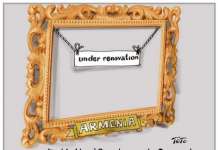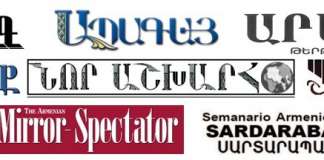By Edmond Y. Azadian
If we discount as legend that the ancestors of our national hero, Vartan Mamigonian, hailed from the Mamgon family in China, relations between the two nations were at their best when Armenian traders moved their merchant ships and cargo from Europe to Asia during the 16th and 17th centuries, before that trade route was taken over by the British East India Company.
Armenian traders from Julfa operated between Venice and cities in the Far East, where they had set up colonies in Java, Surabaya, Jakarta, Madras, Calcutta, Singapore, Hong Kong and other cities. There was an active Armenian community in the northern Chinese city of Harbin well into the Communist era, when Maoist forces completed the takeover of China, driving the nationalist forces of Kuomintang led by Chang Kai-shek to Taiwan.
The relative sizes of the two countries have led to many jokes and anecdotes. For example, the Chinese government, upon learning that anthropologist Margaret Mead had proposed that the United Nations adopt the Armenian language as its official international langue, sent a telegram to Armenia requesting 30 million Armenian-language teachers to instruct the language at Chinese schools.
Moving from humor to more political narrative, did President Nixon and his Secretary of State Henry Kissinger imagine that China would become a dominant figure in world affairs and, at least economically, make the US beholden to Beijing when they decided to play their China card?
At the time, the obsession in the Western capitals was to contain the Soviet Union at any cost. The China card was a tremendous asset which the Nixon-Kissinger team used successfully, driving a wedge between the two major Communist nations, leading eventually to the collapse of the Soviet Empire. But instead, they empowered China to become one of the major forces in the ensuing, multi-polar political scene.
Unlike the Soviets, the Chinese have used autocratic social rule for economic discipline, raising the living standards of a 1.5 billion-strong society. In a hybrid socialist society, billionaires are allowed to succeed while the state officially preaches equality for all. Once again, internationally, their foreign policy was never tainted by ideology; they never tried to export its communist ideology when buying oil from Sudan’s Omar Bashir, accused by the West of perpetrating genocide, nor did they condition their economic penetration of Latin America. On the contrary, they waged a brief war against their ideological kin, Vietnam, after the unification of that war-torn country.
Today China is among the world’s movers and shakers. Its economic power is growing inexorably, parallel to its political and military muscle.
International relations need to be mutually advantageous to the parties engaged in them; therefore what kind of give-and-take is involved in Armenian-Chinese relations? China has helped Armenia in developing its agriculture, but above all, it has supplied much-needed military hardware.
President Serge Sargisian’s first visit to Beijing was received at the highest level of protocol. His second visit in later March this year was equally high-powered.
One may think that Armenia, as a miniscule country, could be crushed among the rivalry of the superpowers, but thus far, it has been managing its foreign policy prudently. A few months ago, when Foreign Minister Eduard Nalbandian was touring Latin American countries, some opposition publications tried to ridicule his visit to that part of the world, which resulted in Bolivia joining the countries which have recognized the Armenian Genocide, and Mexico scrapping plans to dedicate a public park to the late Azeri leader Heydar Aliyev, as well as generating a tremendous amount of goodwill. Incidentally, Venezuela and Nicaragua are the two countries — besides Russia — to recognize the independence of Abkhazia and South Ossetia. There is potential that those counties may eventually recognize the independence of Karabagh (Artsakh) when the conditions are ripe.
Equally successful is Armenia’s China policy. Given the political volatility in the region and rampant corruption in Armenia, individual investors have thus far been far and few in between. Only a powerful country like China could take the risk in investing in Armenia.
Many consider Sargisian’s trip to China as “historic” and “a breakthrough” as it opened the prospects of economic recovery. At the conclusion of the presidential trip, an official communiqué has been issued, where parties pledge to continue the relations “based on mutual respect, equality and reciprocal interest.”
The Armenian side has promised not to recognize Taiwan’s independence, since it considers the island an integral part of China, while the Chinese side agreed to support “the peaceful settlement of the Karabagh conflict on the basis of the principles of UN Charter and universal norms of international law.”
A statement with little and practical significance.
What is more significant is President Zi Jinxing’s acceptance of an invitation to visit Armenia.
The other significant development is the bilateral economic cooperation in the fields of energy, transport, chemical industry, education, science, culture, aviation and tourism. Armenia’s foreign trade with China has reached $588 million in 2014, an increase of 30 percent from the previous year.
China has agreed to provide preferential interstate credit to Armenia. Armenia will join China’s Silk Road Project, which seeks to boost the EEU’s economic activities with China.
Armenia needs any economic stimulus that it can receive, but this China trip also has offered Armenia to brake the narrowing chokehold of transportation and communication network imposed by Turkey and Azerbaijan, with the collusion of Georgia. They have built railway systems and laid gas and oil pipelines bypassing Armenia. China has pledged to invest in the North-South Highway that will connect Georgia and Iran through Armenia.
Another major significant project is the construction of a new nuclear power plant, which Russia promised but never delivered, nor did it allow European countries to develop it.
Military cooperation between the two countries is an existential issue for Armenia, as Russia is arming Azerbaijan alarmingly, while reassuring Armenia that the military balance between the two counties will be maintained by the presence of the Russian military base in Gumri.
Recently, a Russian official announced that Russian arms in Armenia cannot be used to stave off Azeri incursions, leading one to ask when they can be deployed. Can Armenia depend on them? That is why President Sargisian complained recently that the Azeris are using Russian arms to kill Armenian soldiers.
It is hoped that China’s assistance will maintain military parity between the two antagonistic countries.
China is wary of Turkey’s pan-Turanistic ambitions directed toward Central Asia, reaching Beijing’s doorstep. Although the Chinese recently agreed to sell air defense systems to Turkey, knowing well that Ankara has been training terrorists and sending them to China’s Xingjian Province where 8 million Muslim Uyghurs live and they are agitating for independence from time to time. Especially, the East Turkistan Islamic Movement has been very active against Chinese rule. The last time there was a flare-up in the province Erdogan accused Chinese authorities of perpetrating Genocide against their Muslim minority.
The Chinese government realizes that Armenia is one roadblock on Ankara’s pan-Turkic ambitions, no matter how small. Therefore, there is a value in Armenia, which is militarily viable. Perhaps that is where Beijing’s and Yerevan’s strategic interests converge.
Although Benjamin Netanyahu, in his tutorial speech at US Congress stated that “your enemy’s enemy is still your enemy,” in this case, our enemy’s enemy turns out to be our friend.
Considering the relative sizes of the two counties, the recent visit of Mr. Sargisian to Beijing resembles the handshake of David and Goliath, though none of them has ever thrown any stones at each other in the past.















